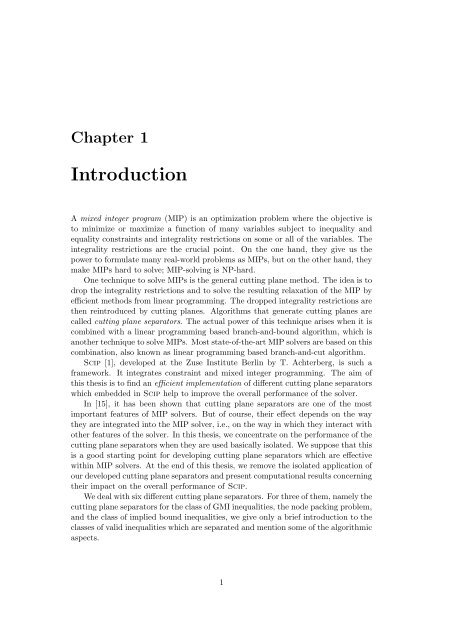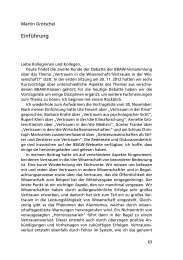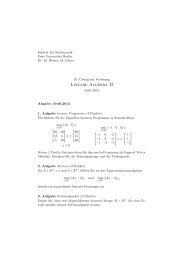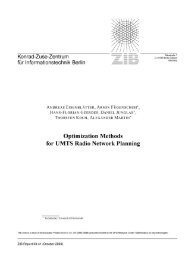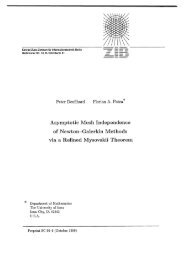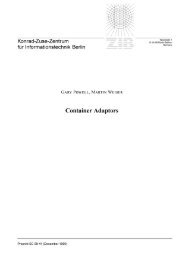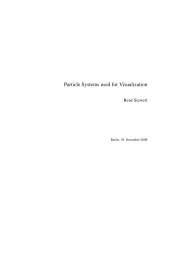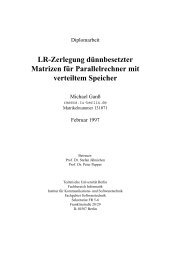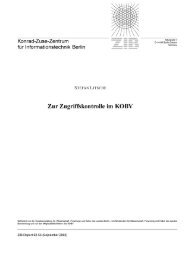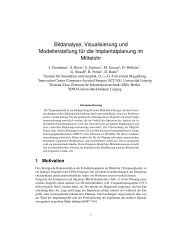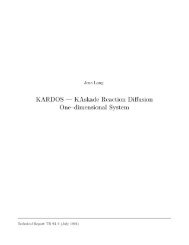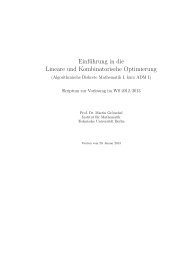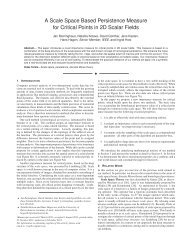Implementation of Cutting Plane Separators for Mixed Integer ... - ZIB
Implementation of Cutting Plane Separators for Mixed Integer ... - ZIB
Implementation of Cutting Plane Separators for Mixed Integer ... - ZIB
Create successful ePaper yourself
Turn your PDF publications into a flip-book with our unique Google optimized e-Paper software.
Chapter 1<br />
Introduction<br />
A mixed integer program (MIP) is an optimization problem where the objective is<br />
to minimize or maximize a function <strong>of</strong> many variables subject to inequality and<br />
equality constraints and integrality restrictions on some or all <strong>of</strong> the variables. The<br />
integrality restrictions are the crucial point. On the one hand, they give us the<br />
power to <strong>for</strong>mulate many real-world problems as MIPs, but on the other hand, they<br />
make MIPs hard to solve; MIP-solving is NP-hard.<br />
One technique to solve MIPs is the general cutting plane method. The idea is to<br />
drop the integrality restrictions and to solve the resulting relaxation <strong>of</strong> the MIP by<br />
efficient methods from linear programming. The dropped integrality restrictions are<br />
then reintroduced by cutting planes. Algorithms that generate cutting planes are<br />
called cutting plane separators. The actual power <strong>of</strong> this technique arises when it is<br />
combined with a linear programming based branch-and-bound algorithm, which is<br />
another technique to solve MIPs. Most state-<strong>of</strong>-the-art MIP solvers are based on this<br />
combination, also known as linear programming based branch-and-cut algorithm.<br />
Scip [1], developed at the Zuse Institute Berlin by T. Achterberg, is such a<br />
framework. It integrates constraint and mixed integer programming. The aim <strong>of</strong><br />
this thesis is to find an efficient implementation <strong>of</strong> different cutting plane separators<br />
which embedded in Scip help to improve the overall per<strong>for</strong>mance <strong>of</strong> the solver.<br />
In [15], it has been shown that cutting plane separators are one <strong>of</strong> the most<br />
important features <strong>of</strong> MIP solvers. But <strong>of</strong> course, their effect depends on the way<br />
they are integrated into the MIP solver, i.e., on the way in which they interact with<br />
other features <strong>of</strong> the solver. In this thesis, we concentrate on the per<strong>for</strong>mance <strong>of</strong> the<br />
cutting plane separators when they are used basically isolated. We suppose that this<br />
is a good starting point <strong>for</strong> developing cutting plane separators which are effective<br />
within MIP solvers. At the end <strong>of</strong> this thesis, we remove the isolated application <strong>of</strong><br />
our developed cutting plane separators and present computational results concerning<br />
their impact on the overall per<strong>for</strong>mance <strong>of</strong> Scip.<br />
We deal with six different cutting plane separators. For three <strong>of</strong> them, namely the<br />
cutting plane separators <strong>for</strong> the class <strong>of</strong> GMI inequalities, the node packing problem,<br />
and the class <strong>of</strong> implied bound inequalities, we give only a brief introduction to the<br />
classes <strong>of</strong> valid inequalities which are separated and mention some <strong>of</strong> the algorithmic<br />
aspects.<br />
1


